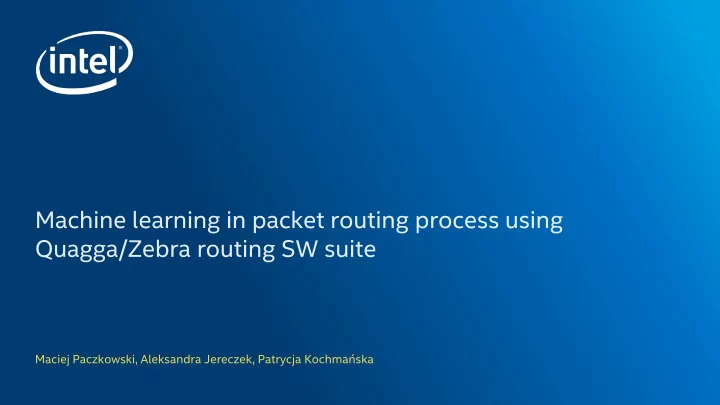

Maciej Paczkowski, Aleksandra Jereczek, Patrycja Kochmańska INTEL CONFIDENTIAL – Internal Only
Agenda 1. Link-state routing protocols 2. Where is the room for improvement? 3. Current LS routing protocols implementation 4. How to use ML in current OSFP/IS-IS networks? 5. Results in simulated environments 6. Potential practical applications and limitations 2 INTEL CONFIDENTIAL – Internal Only
Link-state routing protocols 1. Link-state routing protocols are based on Dijkstra's algorithm (Shortest Path First), which is a deterministic and 100% accurate algorithm for network routes calculation. 2. Most popular: OSPF, IS-IS 3. Question: Where is the room for improvement in those networks? 3 INTEL CONFIDENTIAL – Internal Only
Room for impromevent in SFP protocols 1. Modern networks are getting bigger, more virtualized and more dynamic. 2. Tons of VM are being added or removed every minute. 3. Despite dynamic environment we expect stable and 100% efficient network. 4. However... in case of multiple links failures the time of adaptation in complex scenario may takes even seconds. 5. The idea is to REDUCE the time of the network recovery (self-healing time) in case of multiple link failures. 4 INTEL CONFIDENTIAL – Internal Only
Topology by A1's Router-LSA Topology by A3's Router-LSA Link State DataBase (LSDB) A2 Cost: 10 A2 Cost: 10 Cost: 10 A1 A4 A1 A3 Cost: 10 Topology by A3's Router-LSA Topology by A4's Router-LSA Cost: 10 A2 A4 A1 A4 Cost: 10 Cost: 20 A3 Cost: 10 A3 Topology map LSDB Originator Neighbor Cost (10) (10) A1 A2 10 A2 A1 A3 10 (10) (10) A2 A4 10 A4 A2 A1 10 A1 A3 A4 10 (10) (20) A3 A1 20 (10) A3 (20) A4 A2 10 A4 A3 10 5 INTEL CONFIDENTIAL – Internal Only
Routing and Forwarding tables IP Routing table (RIB): Network Netmask Gateway Interface Metric Destination OSPF 0.0.0.0 0.0.0.0 192.168.0.1 192.168.0.100 10 127.0.0.0 255.0.0.0 127.0.0.1 127.0.0.1 1 192.168.0.0 255.255.255.0 192.168.0.100 192.168.0.100 10 RIB 192.168.0.100 255.255.255.255 127.0.0.1 127.0.0.1 10 192.168.0.1 255.255.255.255 192.168.0.100 192.168.0.100 10 Control Plane IP Forwarding table (FIB): Forwarding plane Prefix Next Hop Interface FIB 0.0.0.0/0 192.168.0.1 Eth0 127.0.0.0/32 Receive n/a 192.168.0.0/24 192.168.0.10 Eth0 INCOMING IP PACKET OUTCOMING IP PACKETS FORWARDING PACKETS 192.168.0.100/24 Receive n/a 192.168.0.1/24 192.168.0.10 Eth0 6 INTEL CONFIDENTIAL – Internal Only
Current LS routing protocols implementation How route calculations are done in current implementations (FRR, Quagga)? 1. SPF calculations (each router builds a tree to reach the other routers) 2. Route resolutions (dependent routes are then resolved, choosing what router to reach in order to route to that destination) 3. Routing table build-up (RIB) 7 INTEL CONFIDENTIAL – Internal Only
Disadvantages of current implementations In current SPF implementations it can be run in Full, Partial or Incremental mode. • Big topology changes requires full SPF recalculation. • During the full SPF recalcution we can observe network outage (in orange). • 8 INTEL CONFIDENTIAL – Internal Only
How to use ML in current OSFP/IS-IS networks? We want to use ML to enhance the • RIB recalculation step. The plan is to add parallel ” AI • algorithm ” along with ”Temporary RIB”. AI algorithm is trained to output the • next hop from the local router to reach each other router in the network. 9 INTEL CONFIDENTIAL – Internal Only
Potential usage of ML in current implementation Using ML we want to generate the temporary FIB in case of network • problems that need the full SPF recalculation. The AI algorithm, for example a Neural Network, is trained based on • previously calculated SPF routes, or on a set of datasets generated in a simulated environment. 10 INTEL CONFIDENTIAL – Internal Only
Potential usage of ML in current implementation The overall goal is to reduce the time needed to have a temporary FIB that • is, with high probability, good enough for the topological state the network is in after the topological change. Temporary FIB is used until the full SPF recalculation has come to its end. • 11 INTEL CONFIDENTIAL – Internal Only
Tests in simulated environments Average Network Outage Time after varioues link(s) failures Time 3 nodes 5 nodes 15 nodes 50 nodes OSPF (N^2 complex.) OSPF + ML (N complex.) 12 INTEL CONFIDENTIAL – Internal Only
Potential practical applications and limitations. Potential utilizations and application: Industrial size data centers • Even one ”intelligent” router node • can decrease average overall network self-healing time. Can be implemented in FRR, Quagga • or any other SW routing suite. Limitations: Will not resolve congestion • problems. 13 INTEL CONFIDENTIAL – Internal Only
Recommend
More recommend